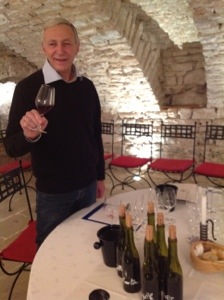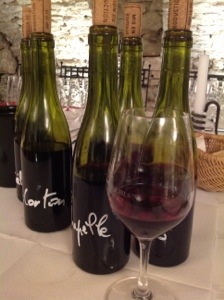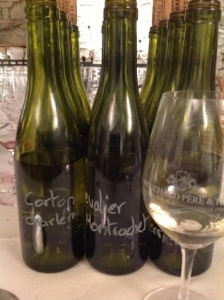Tasting Burgundy 2012 with a master: Philippe Prost of Bouchard Pere & Fils
November 13, 2013
By Panos Kakaviatos
Using stems is not necessary in winemaking and those who think that a Burgundian wine made with stems is necessarily good are wrong, remarked Philippe Prost, director for Bouchard Pere & Fils in Beaune, as we tasted through 12 2012s today, 13 November.
2012 was more a red vintage he said. And although he likes to ferment with whole berry clusters, stems and all, the stems for the white grapes were sometimes green and bitter. So only about 60% of the whites were fermented using stems. Chardonnay handled the vicissitudes of the vintage – shattering, oidium, rot – less well than Pinot Noir, Philippe said.
Indeed, he called the white harvest a “trap” in 2012. “You will find that many whites will either be flabby – a sign of heat peaks in the latter part of August – or hard and underripe, a sign of picking too early. For the whites, “you really had to go vineyard to vineyard and taste the grapes carefully,” he added.
For the reds, more dry extract than in 2009, as the grapes were more compact and ripe – and similar acidities. He said that the reds were more immediately amenable than, say, the 2010s, which were more edgy early on.
Notably, the stems of the reds were riper and readier for the fermentation vats than those for the whites. Was there one appellation among the whites that performed best? Philippe said Puligny.
We started as is custom tasting the reds first. The Monthelie was rather tannic and powerful, lacking a bit of charm. Philippe said that a sample tasted that morning performed better.
The Beaune Clos de la Mousse had a savory almost sweet nose, with a musk like perfume that proved delicious. The palate was fairly opulent, with spicy aspects again, and red cherry. Fine tannic grain.
But we entered a higher level with the Beaune Greves Vigne de l’Enfant Jesus. Much richer and deeper on the nose, almost velvet. Philippe said that since 2011, two plots of vines give off particularly strong aromas when grapes are fermented with the stems. Just under 30% new oak. Well integrated, and precise on the finish. Lovely wine.
The Nuits Saint Georges Les Cailles was more brooding. More feutré, as the French say… Like a dark nightclub. I could sense a bit of subtle plant. No don’t worry, this was not green, but rather complex. Indeed, fermented with 50 percent stems. And much depth on the mid palate through go the finish, rather baritone in style. The wine is still in barrel, not yet racked.
Le Corton was brighter, with ripe fruit expressions of blackberry, and touches of smoke, even pencil lead. I got the impression here of a wine that was more settled than the preceding wine, and a bit more balanced. What I liked most was the matiere and the sap on the mid palate: a very juicy wine.
But the best came last, with a spherical Chapelle Chambertin, whose deep and bright nose seemed to be accentuated with a dollop of vintage port. The grapes are purchased from a grower, then vinified at Bouchard, from .75 hectares. The palate is clean, polished and deep, a contained richness that holds much promise for the future. This and the Jesus were perhaps my overall favorites, from memory…
And then we tasted the whites. Much less new oak used in general for thewhites. A few years ago, Bouchard would purchase 1900 new oak barrels. These days, more like 500, Philippe said.
The complete blend and now in stainless steel tanks, the Beaune Clos Saint Landry was rather peach Iike in aspect, a touch of musk. The palate is somewhat thick but not that heavy, with an orange/grapefruit peel tinged finish. Good.
Meursault Les Clous. Made from the cooler part of the already cool climate… Nose has red apple and some citrus but the palate is somewhat flat. I usually like this wine, but perhaps the vintage was not ideal.
Meursault Les Genevrieres. Another dimension. Seductive, with a sweet summer flower aspect, and fresh cut hay. On the palate a touch of almond and macaroon. A filtered sample taken from final blend, just eight days ago. Fine if not extremely precise.
Meursault Les Perrieres. If one appellation from Meursault deserves grand cru, it is this one, Philippe said. Complex nose, with nougat, wet stone, lime, and just far more subtle and precise on the palate than the preceding wine. Clearly a winning white in 2012 from Bouchard.
Corton Charlemagne. Now honestly not sure if this is better than preceding wine. Philippe compares it to the … 1953, which was also very rich but lasts a long time – he explained that the vines belonging to Bouchard are located in a very cool climate hence “we always have acidity” … The color was a rather deep tone. And yes I got richness, like red licorice candy, but also ripe grapefruit and salinity on the tonic finish with a mineral note akin to white pepper. Quite delicious. Harvested late, about 3 October. Philippe said too many worry about picking too late, they want “purity” but sometimes end up being as pure as “rocky spring water” – and just as “neutral” in flavor… Was it possibly a touch warm?
The Chevalier Montrachet – always among my favorites from Bouchard – was superb. More delicate, more floral, more airy, and very iodine like with layered texture and a nuanced, subtly long lemon/lime finish. This was the final blend, with just under 20% new oak. I think this was my favorite from the whites.



